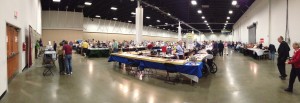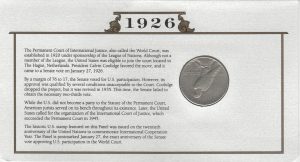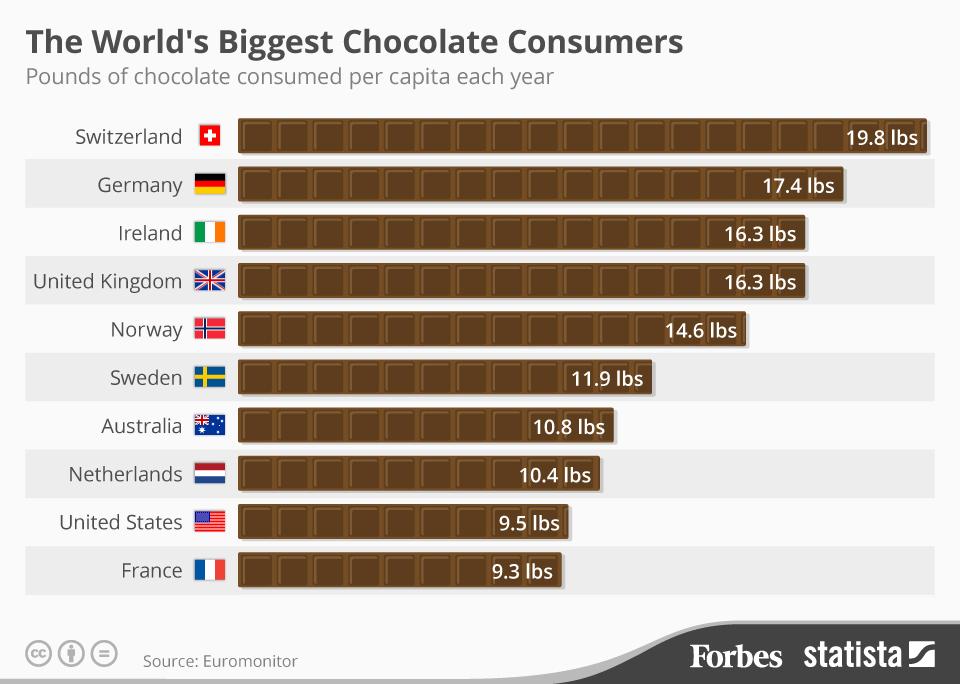Jun 1, 2018 | coin design, coins, gold, legislative
Although it is not really a numismatic-related bill, the Saint-Gaudens National Historical Park Redesignation Act appears to be on track for passage in the Senate.
Essentially, the bill redesignates the Saint-Gaudens National Historic Site, Augustus Saint-Gaudens’ former home in New Hampshire, as the “Saint-Gaudens National Historical Park.” The change is significant in that it changes the funding for the staffing and maintenance of the site. It also will keep the site accessible for tourism.
Augustus Saint-Gaudens is known as the artist who co-conspired with President Theodore Roosevelt in his “pet crime” to redesign United States coinage. Before his death in 1907, Saint-Gaudens provided the design for the $20 Double Eagle and $10 Eagle gold coinage.
Saint-Gaudens’ legacy did continue after his death by his students Adolph A. Weinman, designer of the Walking Liberty half-dollar and Mercury dime, and James Earle Fraser, designer of the Buffalo Nickel.
S. 2863: National Law Enforcement Museum Commemorative Coin Act
Read twice and referred to the Committee on Banking, Housing, and Urban Affairs. — May 16, 2018
H.R. 965: Saint-Gaudens National Historical Park Redesignation Act
Summary: (Sec. 2) This bill redesignates the Saint-Gaudens National Historic Site, in New Hampshire, as the "Saint-Gaudens National Historical Park."
Referred to the House Committee on Natural Resources. — Feb 7, 2017
Placed on the Union Calendar, Calendar No. 197. — Aug 25, 2017
Reported (Amended) by the Committee on Natural Resources. H. Rept. 115-277. — Aug 25, 2017
Mr. Thompson (PA) moved to suspend the rules and pass the bill, as amended. — Oct 2, 2017
Considered under suspension of the rules. — Oct 2, 2017
DEBATE – The House proceeded with forty minutes of debate on H.R. 965. — Oct 2, 2017
At the conclusion of debate, the Yeas and Nays were demanded and ordered. Pursuant to the provisions of clause 8, rule XX, the Chair announced that further proceedings on the motion would be postponed. — Oct 2, 2017
Considered as unfinished business. — Oct 2, 2017
On motion to suspend the rules and pass the bill, as amended Agreed to by the Yeas and Nays: (2/3 required): 401 – 0 (Roll no. 545). — Oct 2, 2017
Motion to reconsider laid on the table Agreed to without objection. — Oct 2, 2017
Received in the Senate and Read twice and referred to the Committee on Energy and Natural Resources. — Oct 3, 2017
Committee on Energy and Natural Resources. Ordered to be reported without amendment favorably. — May 17, 2018
Jun 1, 2018 | coins, commentary, gold, US Mint
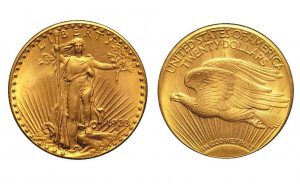
One of the ten 1933 Saint-Gaudens $20 Double Eagle gold coins from the Longbord Hoard confiscated by the U.S. Mint
Coin World reported that the previous owner, who wishes to stay anonymous, turned in the coin because he did not want to be caught with the coin that federal courts ruled was stolen government property. Department of the Treasury and U.S. Mint officials have been instructed by the Department of Justice not to go into any further details about the case.
Since it has been assumed that 25 of these coins were taken from the Philadelphia Mint, that leaves four left at large.
According to Coin World, “The Secret Service still has on its books a directive to seize any extant 1933 double eagles as stolen government property.” However, other coins, patterns, and fantasy pieces including the five 1913 Liberty Head Nickels and the 1974 Lincoln Cent trial strike made from aluminum are still in private hands.
As long as this bogus double standard remains the policy of the federal government, we will likely never know whether the rumored 1964 Peace Dollars are real.
May 29, 2018 | coins, dollar, history, US Mint

Randy’l Teton interview on East Idaho Newsmakers (screen grab)
Since there are no known images of Sacagawea, Goodacre searched for someone she could model her design on. Goodacre found Randy’L He-Dow Teton is a member of the Shoshone-Cree tribe to be the model. Teton was a student at the University of New Mexico majoring in art history and was working for the Institute of American Indian Arts Museum in Santa Fe when Goodacre visited looking for information about the Shoshone tribe. While talking with the museum’s curator, Goodacre was shown a picture of the curator’s daughter, Randy’L, and decided to work with her to create the Sacagawea design.
Recently, Teton sat with Nate Eaton of EastIdahoNews.com for his series East Idaho Newsmakers. Although they cover other topics, most of the video is about Teton’s experience as being the model for Sacagawea.
EastIdahoNews.com does not provide the ability to embed the video elsewhere on the web. To watch the video and hear the story from Teton’s point of view you can visit the site: Newsmakers: The fascinating story of how this local woman ended up on the dollar gold coin.
May 27, 2018 | coins, currency, dollar, foreign
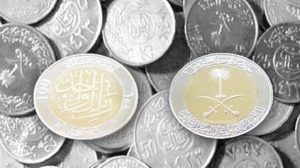
Saudi Arabia to replace the one-riyal note with coins (Image courtesy of Asharq Al-Awsat)
SAMA made the announcement as part of their introduction of new coin designs using modern techniques in coin manufacturing.
Under their transition plan, SAMA will allow the SR1 paper note to circulate alongside the new coin as the notes will be withdrawn from circulation. When the coins become available, the banks will be ordered to replace the SR1 note with a coin based on an availability formula that will be provided when the coins are ready for circulation.
According to Society for Worldwide Interbank Financial Telecommunication (SWIFT), the company that runs the network that enables the world’s financial institutions to security send financial transactions to each other, the United States dollar makes up 40.86-percent of every transaction in the world (as of February 2017). The United States Gross Domestic Product (GDP), the measure of an economy’s output, is over $19 trillion (in 2017 according to the International Monetary Fund) more than any country or trading cooperative (such as the European Union). But the United States is the only country ranked in the Top 10 of either of these lists to continue to produce its unit currency in paper form.
For a country that is supposed to be a leader, it looks like the United States has fallen behind the rest of the world. It is time to eliminate the one-dollar Federal Reserve Note.
And now the news…

May 20, 2018
A new £1 coin could actually end up earning you hundreds thanks to a Royal Mint 'error'. Three examples of the error have already been seen by ChangeChecker – and they are selling for more than £200.  → Read more at bristolpost.co.uk
→ Read more at bristolpost.co.uk

May 22, 2018
Prosecutors won’t pursue charges against a drummer accused of stealing rare coins and a passport from famed New Orleans musician Fats Domino.  → Read more at pagesix.com
→ Read more at pagesix.com

May 22, 2018
The sifting project, which has operated since 2004 in the Emek Tzurim National Park, aims to salvage religious and historical artifacts from the rubble, as well as to educate the public about the veracity of Jewish history on the Mount.  → Read more at jns.org
→ Read more at jns.org

May 22, 2018
Aaron Judge and Michael Conforto are two of the young stars that New York baseball fans have been buzzing about the past two years. Now fans of the Yankees and Mets outfielders can now get the star…  → Read more at nysportsday.com
→ Read more at nysportsday.com

May 24, 2018
2018 Baseball Treasure MLB Coins checklist, release date, silver and gold coin info and all you need to know about the officially licensed set of baseball coins.  → Read more at beckett.com
→ Read more at beckett.com

May 25, 2018
The much-ballyhooed summit between the United States and North Korea met its end Thursday. The cancellation, for now, stamps out the prospects for peace, yet does nothing to stop the snazzy coins featuring Donald Trump and Kim Jong Un in front of patriotic backdrops surrounded by olive branches  → Read more at cnn.com
→ Read more at cnn.com

May 25, 2018
The Saudi Arabian Monetary Authority (SAMA) will start withdrawing SR1 banknotes from the market from Thursday, SAMA has said. In a statement, SAMA announced issuing its sixth edition, which was developed during the reign of the Custodian of the Two  → Read more at aawsat.com
→ Read more at aawsat.com
May 22, 2018 | coins, commentary, gold, legal, US Mint
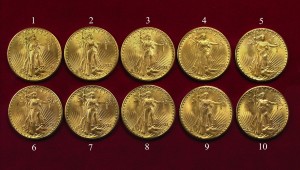
The ten 1933 Saint-Gaudens Double Eagles confiscated by the government from Joan Lanbord, daughter of Israel Switt.
For those who have not read Illegal Tender by David Tripp or Double Eagle by Allison Frankel, aside from both being worth reading, they claim that 25 of these coins were illegally removed from the Philadelphia Mint. Of those 25 coins, nine were confiscated during the 1940s and 1950s by the Secret Service, ten are from the Langbord Hoard stored at the Bullion Depository at Fort Knox, and one is the Farouk-Fenton example which is the subject of the books.
That leaves five left.
During the Pennsylvania Association of Numismatics (PAN) spring show, U.S. Mint Senior Legal Counsel Greg Weinman said that he knows where one is located in the United States, one is in Europe, and a third is somewhere else. The location of the last two is not known.
It can be speculated that the “somewhere else” may be in Egypt. On February 8, 2008, the Moscow News Weekly reported that a version of the coin was found in Egypt in an old box that was owned by the discoverer’s father (web archive link). Although there had been a lot of speculation that coin might not be genuine, there has been no further reports as to the disposition of this coin.
Weinman said that there are no plans to go after the three coins where the U.S. Mint knows their location.
Why?
Following the trial in 2011 with a jury verdict against the Langbords. After the ruling, Assistant U.S. Attorney Jacqueline Romero, the government’s lead attorney in the case, came out with a courthouse statement, “People of the United States of America have been vindicated.”
If the country is to be vindicated and the government has consistency in its argument that the coins are “chattel,” according to Weinman, then it is their legal obligation to have the U.S. Secret Service pursue the three known examples.
Otherwise, it could be said that the government has undergone selective prosecution and has given up its right to the ten in its possession or the five that are still in public hands.
It is these inconsistencies of policies with regard to these coins that could drive collectors away. While most people may never find or own one of these rare coins, what happens to those who might get lucky.
While the 1913 Liberty Head Nickels were not considered chattel because they were never struck for circulation, the government fought the finding of the 1974-D Aluminum cent forcing its return. The circumstances for the striking of both coins are similar but the government has treated each issue differently.
This is not a matter of integrity of the hobby. It is the integrity of the U.S. Mint and their bogus argument of what is or is not something they produced for whatever the reason. The integrity of the U.S. Mint can be questioned when they applied 21st century operating standards to the U.S. Mint of the 1930s in order to convince a “jury of peers,” none of which probably had a numismatic background questioning their ability to be peers, that these coins belonged to the government for it to hold like some almighty savior of us from the depths of fraudulence.
Do you still feel vindicated?
May 20, 2018 | Australia, coins, news
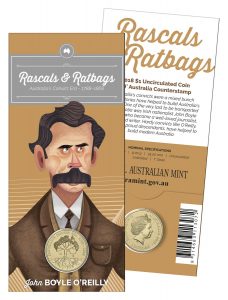
A Rascals and Ratbacs Souvenir card with attached coin (Image Courtesy of the Royal Australian Mint)
After the British discovery of Australia in 1770, they initially settled the colony of New South Whales by exiling criminals to the area. Although there were free colonies in Australia, it became known as Britain’s penal colony. Rather than bemoan their sketchy past, especially since they have moved on to become a successful nation, the Royal Australian Mint seems to have embraced their history to have a little fun and promote coins.
Using its yearly roadshow, the Royal Australian Mint kicked off its Rascals and Ratbags Roadshow Reveal at the Mint in the capital city of Canberra to introduced the Rascals and Ratbags coins. These coins celebrate the 230th Anniversary of the arrival of the First Fleet on the island nation and the 150th anniversary of the Hougoumont, the last ship to carry convicts to Australia.
The coin is available in Australia as a four-coin uncirculated mintmark and privy mark set, a $1 (AUD) silver proof with the “C” (Canberra) mintmark, and a one-tenth ounce $10 (AUD) gold proof coin also with the “C” mintmark.
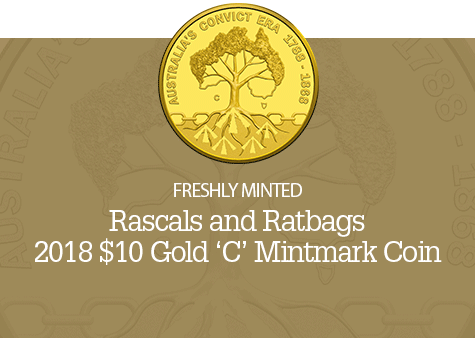
(Image courtesy of the Royal Australian Mint)
Since these are not colored coins they will not be a subject of their lawsuit with the Royal Canadian Mint.
As part of the celebration, the Royal Australian Mint is traveling with a portable press to allow visitors to strike a special Australia counterstamp in their coins.
It goes to show that rather than dwell on your past problems, fix them and move on. Have a little fun at your own expense. It is certainly better than the arguing that pervades the United States.
And now the news…

May 9, 2018
That Makes Cents It’s a U.S. Mint.  → Read more at kqed.org
→ Read more at kqed.org

May 12, 2018
Canberra’s coin enthusiasts head to Royal Australian Mint for special roadshow reveal.  → Read more at canberratimes.com.au
→ Read more at canberratimes.com.au

May 15, 2018
On March 6, Ghana’s Independence Day, artist Yaw Owusu was crouched on his living room floor, putting the finishing touches on a new piece. Stretching over most of the floor, the work sparked silver and copper as the sun bounced off the carpet of pesewa coins — the country’s least valuable currency and Owusu’s preferred medium.  → Read more at ozy.com
→ Read more at ozy.com

May 16, 2018
Break out those piggy banks – if you can get your hands on some old Irish punt, you've basically won the lotto. According to The Central Bank's annual report, $270.4 million (€226m) worth of old Irish punts remains unaccounted for.  → Read more at irishcentral.com
→ Read more at irishcentral.com

May 16, 2018
The Tokyo Metropolitan Police Department has arrested a man on suspicion of selling counterfeit 2020 Tokyo Olympic and Paralympic commemorative coins. Yasuhiro Kotani, 43, was arrested for allegedly violating the trademark law by possessing the imitations in order to sell them.  → Read more at japantimes.co.jp
→ Read more at japantimes.co.jp

May 18, 2018
Venkatesh Kandula believes in tracing history through coins. The numismatist from Tuni has around 1,800 coins in his kitty, some that are historical rarities. On World Museum Day, Kandula displayed his treasure trove of rare coin collections at Visakha Museum on Friday.  → Read more at thehindu.com
→ Read more at thehindu.com

May 19, 2018
OUT OF CIRCULATION SOON These are some of the “Flora and Fauna” and “Pilipino” coin series to be demonitized. The Bangko Sentral ng Pilipinas (BSP) announced on Friday the start of the demonetization process  → Read more at newsinfo.inquirer.net
→ Read more at newsinfo.inquirer.net
May 18, 2018 | advice, coins, shows, values
If you are a collector of anything you know that the price of your collectible is based on both a market valuation and what you are willing to pay. There are a lot of market valuation tools for the numismatic collector. One of the more popular ones is The Coin Dealer Newsletter and associated publications that track market trends.
In 2012, I wrote a two-part series about how coins are priced (see Part I and Part II) where I discussed not only how the coins are priced by the different markets for purchasing coins. Last year I wrote about other venues to buy your coins and then earlier this year I added information about estate auctions. All have their audiences, which expands the buying options.
One important factor I discussed is how to negotiate. In “How Are Coins Priced (Part II),” I wrote about negotiating from the perspective of the collector. At the time, I had just started my collectibles business and did not have the experience from the other side of the negotiation table to understand from their perspective.
I thought about this when I stumbled upon an article in Sports Collectors Digest about negotiating. The author spoke to collectors and dealers about their negotiating styles and conditions for negotiating. While the information about negotiating from the collector’s perspective is not that different than what I originally wrote, the impression from the dealer’s perspective is what I have witnessed.
My experience and the article provides two aspects of negotiating from the dealer’s perspective that I want to highlight here.
First, I want to emphasize the concept of BE POLITE! While most people are polite, there have been times I have wanted to punch a customer in the mouth. While I do not mind a little aggressive negotiating being rude will not make me want to work with you on the price.
Second, understand that you are not only buying an item but selling each collectible comes with a cost. Aside from the cost of the inventory, the dealer has overhead. At a show, the dealer has travel expenses. In a shop, there are expenses with maintaining the store.
Even auctions have expenses. Seller fees can be from 25 to 50-percent of the sale price in many professional auctions. Even eBay charges a final value fee for selling on their site and sometimes there are listing fees. While you might complain about paying more than the postage for the shipping costs, there are labor and material costs for packaging your winning item in addition to the postage.
To highlight the issue, the author spoke with a baseball card dealer who said:
This dealer also wanted another “fact of doing business” relayed to others here. He wasn’t saying the mark-up on his items always came to 100 percent of his original purchase price for those items. Rather, if he buys a card for, say, $50, he has to sell that same card for roughly $100 because within that price would be his other costs (lodging, food, transportation, and so forth). Therefore, when the other expenses are factored in, in reality he may be making just 10 percent profit on that card.
The same thing could be said for numismatics as well.
May 17, 2018 | coins, dollar, eBay, Peace
While browsing on eBay, I noticed a few auctions of what I thought were philatelic (stamp collecting) cachets with Morgan and Peace dollars honoring different aspects of history. Not knowing much about them, I placed some bids based on the estimated values of the coins.
The difference between a First Day Cover (FDC) and a cachet is that the FDC is stamped on the first day of issue usually with a special commemorative postmark. A cache is a souvenir cover that is not postmarked as the first day of issue.
Another interesting collectible that combines philately and numismatics is called a Philatelic Numismatic Cover (PNC) or sometimes just coin cover. The U.S. Mint has produced coin covers for the 50 State Quarters, Westward Journey, and Presidential Dollars series as well as the first Sacagawea dollar. These are fun collectibles and something I will talk about in the future.
When the auctions were over, I won one with the 1926-S Peace dollar. Although the description seemed in order, I did not know what to expect. When it arrived I think it is more interesting than advertised.
First, the item is not an envelope by a heavy stock card that is 9-inches long by 4.875-inches wide. It is to honor the anniversary of the United States agreeing to join the World Court on January 27, 1926. The card includes a 5-cents stamp commemorating International Cooperation Year that was issued on June 26, 1965, and a 33-stamp that was in use when this was created in 2001. It is postmarked on January 27, 2001 in Washington, D.C., the 75th anniversary of the event.
The Peace dollar is definitely circulated and would probably grade in the Very Fine range if sent to a third-party grading service. It is encased in plastic which is sandwiched between two panels of cardboard to make up the card. The back of the card has a longer narrative of the history.
Originally, I was only interested in it for the coin since I am a fan of the Peace dollar. But seeing the card makes me wish I would have bid higher for more of them. The other problem is that I do not know who made them. This card looks similar to ones described as being from the Postal Commemorative Society. However, I have seen several different descriptions to make me unsure.
If anyone can provide more information, please post it as a comment below. I would like to learn more!
May 13, 2018 | celebration, coins, museum, news
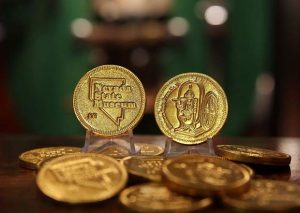
Chocolate coins in honor of the 150th anniversary of the historic Coin Press No. 1 are on sale at the Nevada State Museum’s store. (Courtesy of Jeanette McGregor via the Nevada Appeal)
Chocolate is one of the most complicated flavors, evident by the inability to produce artificial versions.
Scientists have discovered that The smell of chocolate increases theta brain waves, which triggers relaxation. And dark chocolate has been found to have health values including containing antioxidants, widens the arteries to increase the flow of blood and prevent the buildup of plaque, has anti-inflammatory powers, and when eaten daily can reduce the risk of heart disease by one-third.
Every second, Americans collectively eat one hundred pounds of chocolate. But Americans are only ninth when considering the per capita pounds of chocolate consumed by country. The top honor goes to the Swiss people who consume an average of 19.8 pounds of chocolate each. Americans only consume an average of 9.5 pounds.
Why this obsession with chocolate on the Coin Collectors Blog?
Aside from being Mother’s Day, the Friends of the Nevada State Museum has created a chocolate coin in tribute to the 150th anniversary of Coin Press No. 1. The Museum, located in Carson City in the old CC Mint building, continues to use Coin Press No. 1 to strike medals for visitors as part of demonstrations.
On your next visit to Carson City or the area, stop by the Museum, strike your own silver medal, and buy one of their commemorative chocolate coins. I have heard they were described as “wicked good!”
HAPPY MOTHERS DAY TO ALL OF OUR MOMS!
And now the news…

May 4, 2018
Rare collectible coins can be worth far more than their face value – and the rarest 50p design regularly sells for 160 times what it’s worth. But which coins should you look out for in your change? Which?  → Read more at which.co.uk
→ Read more at which.co.uk

May 5, 2018
Recycling flows defy price rise because jewelry holdings 'already depleted'… GOLD COIN and small-bar investors in the West have begun selling metal while household sales of 'scrap' jewelry have fallen to 10-year lows according to new data.  → Read more at bullionvault.com
→ Read more at bullionvault.com

May 6, 2018
Philip Foreman, 51, started his collection a year ago  → Read more at kentlive.news
→ Read more at kentlive.news

May 9, 2018
While Joel Kimmel may not be attending the wedding of Prince Harry and Meghan Markle on May 19, the Ottawa-born illustrator’s connection to the soon-to-be royal couple will be forever etched …  → Read more at ottawacitizen.com
→ Read more at ottawacitizen.com

May 10, 2018
" /> <meta property=  → Read more at globenewswire.com
→ Read more at globenewswire.com

May 10, 2018
The Friends of the Nevada State Museum, in tribute to the upcoming 150th anniversary of the Museum’s historic Coin Press No. 1, have “minted” chocolate coins for sale at  → Read more at nevadaappeal.com
→ Read more at nevadaappeal.com

May 10, 2018
Archaeologists digging in an historic part of central Moscow have found all sorts of objects in recent months, but perhaps nothing as interesting as the oldest example of a pickpocket's coin to come to light in the city.  → Read more at bbc.com
→ Read more at bbc.com
May 10, 2018 | coins, foreign
Sometimes it can be fun to search through junk boxes or bags of foreign coins. While you can see a lot of the same coins accumulate in these bags there are others that look interesting.
During our local coin club meeting, members bring in coins to sell to other members. One member, a very prolific collector, had a large plastic bag of circulated foreign coins. I was first drawn to the back by some of the shapes I found. I grabbed a handful and one coin fell on the table that really caught my eye.
It was a small coin. A very small coin. Nobody had a caliper but it was really small. Even though I was looking at the different shapes, I found this very small round coins intriguing. What was it?
Although I should become better at recognizing languages that are not based on the Latin alphabet, I asked my fellow club member if they could help identify the coin. He said that he could not identify the coin but recognized the lettering as being from India.
With that knowledge, I did not have to search the entire Standard Catalog of World Coins to figure it out. Start at the beginning of the Indian coins and see what we could find.
After a few minutes of looking, I found the listing. Then I found a second one that was very similar. Which coin did I have and where did it come from?
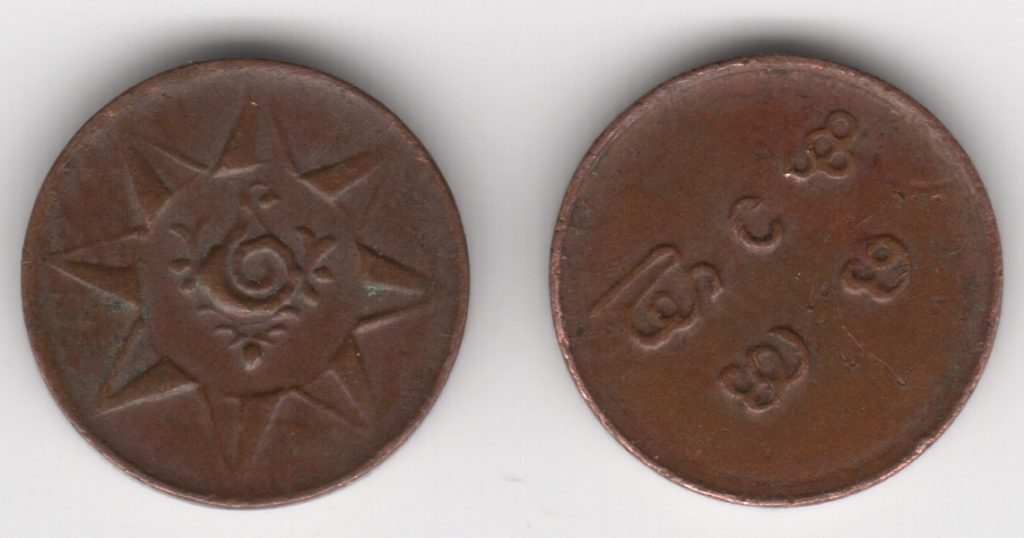
Travancore One Cash coin (KM #40). Undated but was struck from 1901 through 1910.
The coin is from the Princely State of Travancore. It was located in the southwest of the Indian subcontinent. Travancore became its own state in 1729 when it passed under Muslim control. Its economy was driven by making an alliance with the East India Company to freely use its ports for trade. Because of this arrangement, Travancore was never a part of the British Empire and continued to remain independent until 1949 when India was united as one country.
Only two rulers issued coins in the State. Rama Varma VI lead from 1885 through 1924 and Bala Rama Varma II ruled from 1924 through the end of the kingdom in 1949. Coins were issued by the kingdom to make up for lost revenues when the British became distracted by other world events.
Regardless of which version of the coin, it is a “ONE CASH” coin made of copper. The obverse is a sankha (conch shell) in an 8-pointed star with the reverse reading “Onu Kasu’ (one cash).
One version, under the rule of Rama Varma VI, was .65 grams of copper (KM #40) and the other, under the rule of Bala Rama Varma II, is .48 grams of copper (KM #57). Since my scale is not that sensitive, I had to find another way to diagnose this coin.
According to the SCWC, KM #57 was struck on a thin planchet that measures .8 mm. After making sure that my digital caliper can measure 1 mm, using a piece of metal that is 1 mm thick, I would be reasonably certain I could determine which coin I have.
Measuring both coins, the caliper read 1.02 mm giving evidence that this is the early version of the coin (KM #40)
Given the difference of only .22 mm, the only way to tell the difference would be either to weight the coins or use a caliper.
Since I had the caliper out, I measured the diameter and found it to be 10.72 mm.
For fun, I had to determine whether it was smaller than the 1904 Panama 2½ Centesimos coin, better known as the Panama Pill. Previously, I wrote that the Panama Pill was 10 mm in diameter. After finding the coin and measuring it, it was 10.12 mm in diameter making it than a little more than a ½ of a millimeter smaller than the Travancore One Cash coin.

Travancore One Cash coin from the early 20th century versus the 1904 2½ Centesimos coin, better known as the Panama Pill.
On a quick look, it appears that the most common “small” coin size is 15 mm. Some are slightly larger but not many smaller. The only other coin I found is a British 1½ pence coin that was struck for Ceylon, British Guiana, British West Indies and Mauritius that is 12 mm in diameter, I cannot find any smaller.

Surrounding the United States Dime is a 1904 Panama 2½ Centesimos coin (Panama Pill) and a 1901-1910 Travancore One Cash coin.
If anyone knows of smaller coins, please let me know.




 → Read more at
→ Read more at 


